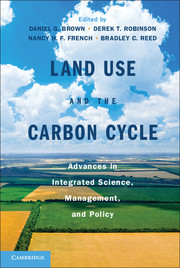Book contents
- Frontmatter
- Contents
- Chapter Authors and Affiliations
- Acknowledgments
- Acronyms
- Part I Introduction
- Part II Measurement and Modeling
- Part III Integrated Science and Research Applications
- Part IV Land Policy, Management, and the Carbon Cycle
- 13 Managing Carbon: Ecological Limits and Constraints
- 14 Effects of Wildland Fire Management on Forest Carbon Stores
- 15 Soil Carbon Dynamics in Agricultural Systems
- 16 U.S. Policies and Greenhouse Gas Mitigation in Agriculture
- 17 Opportunities and Challenges for Offsetting Greenhouse Gas Emissions with Forests
- 18 Opportunities and Challenges for Carbon Management on U.S. Public Lands
- 19 Design and Planning of Residential Landscapes to Manage the Carbon Cycle: Invention and Variation in Land Use and Land Cover
- Part V Synthesis and Future Directions
- Index
- Plate Section
- References
18 - Opportunities and Challenges for Carbon Management on U.S. Public Lands
Published online by Cambridge University Press: 05 February 2013
- Frontmatter
- Contents
- Chapter Authors and Affiliations
- Acknowledgments
- Acronyms
- Part I Introduction
- Part II Measurement and Modeling
- Part III Integrated Science and Research Applications
- Part IV Land Policy, Management, and the Carbon Cycle
- 13 Managing Carbon: Ecological Limits and Constraints
- 14 Effects of Wildland Fire Management on Forest Carbon Stores
- 15 Soil Carbon Dynamics in Agricultural Systems
- 16 U.S. Policies and Greenhouse Gas Mitigation in Agriculture
- 17 Opportunities and Challenges for Offsetting Greenhouse Gas Emissions with Forests
- 18 Opportunities and Challenges for Carbon Management on U.S. Public Lands
- 19 Design and Planning of Residential Landscapes to Manage the Carbon Cycle: Invention and Variation in Land Use and Land Cover
- Part V Synthesis and Future Directions
- Index
- Plate Section
- References
Summary
Introduction
Public lands are important constituents of the U.S. carbon (C) balance because they encompass large areas of forests and rangelands, although whether and how C might be actively managed on public lands is not yet clear. A decision to manage public lands for their C benefits would involve a complex set of interacting drivers and multiple jurisdictions, and would, as they are now, be governed by laws mandating multiple uses of land in the public domain.
As with any lands subject to management, some public lands have significant potential to sequester additional C beyond current levels in vegetation and soils as well as in wood products extracted from the land. However, there is currently no comprehensive assessment of the potential for C sequestration to be enhanced in public lands in particular. An assessment of the potential for increasing the stocks of C in vegetation and soils on public lands above current levels should take into consideration the biological potential to sequester and store additional C (including analysis of risks of reversal from natural disturbances); the economic potential, which reflects the influence of C price on activities; and the social/political potential, such as laws, regulations, and institutional capacity (Failey and Dilling 2010). In this chapter, we review these challenges and the potential for sequestering C on public lands. We first review the institutional context of public land management in the United States, including the federal, state, and local governmental levels. We then evaluate the opportunities for C management given the large acreage of land and vegetation types in the public domain, how decision-making operates, and what has already occurred in terms of agency leadership in the area of C management. We follow with a brief analysis of some of the challenges of deliberately managing C on public lands. We conclude by describing several C-related pilot projects under way and suggest implications for the future of C management on public lands.
- Type
- Chapter
- Information
- Land Use and the Carbon CycleAdvances in Integrated Science, Management, and Policy, pp. 455 - 476Publisher: Cambridge University PressPrint publication year: 2013
References
- 6
- Cited by



